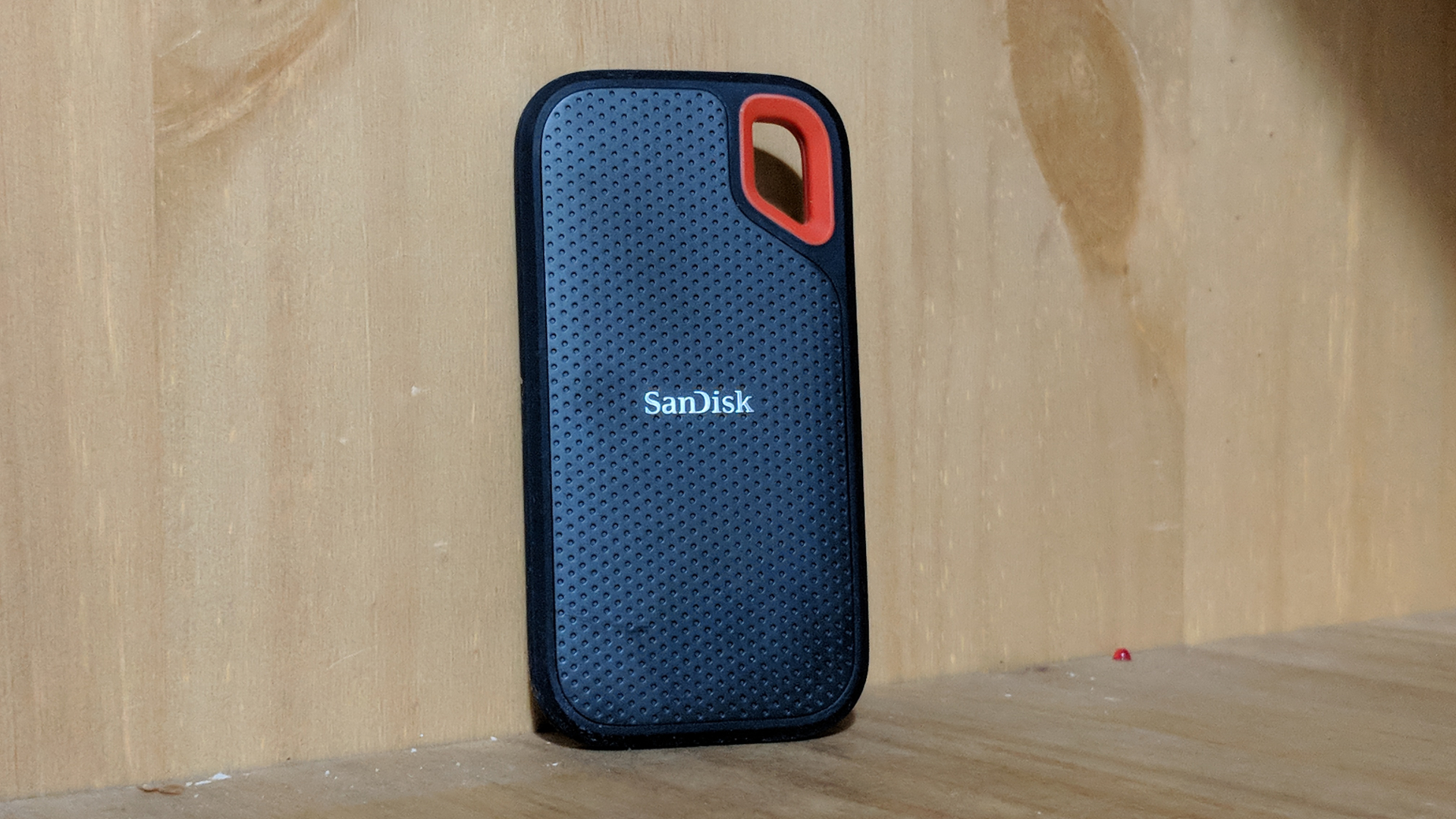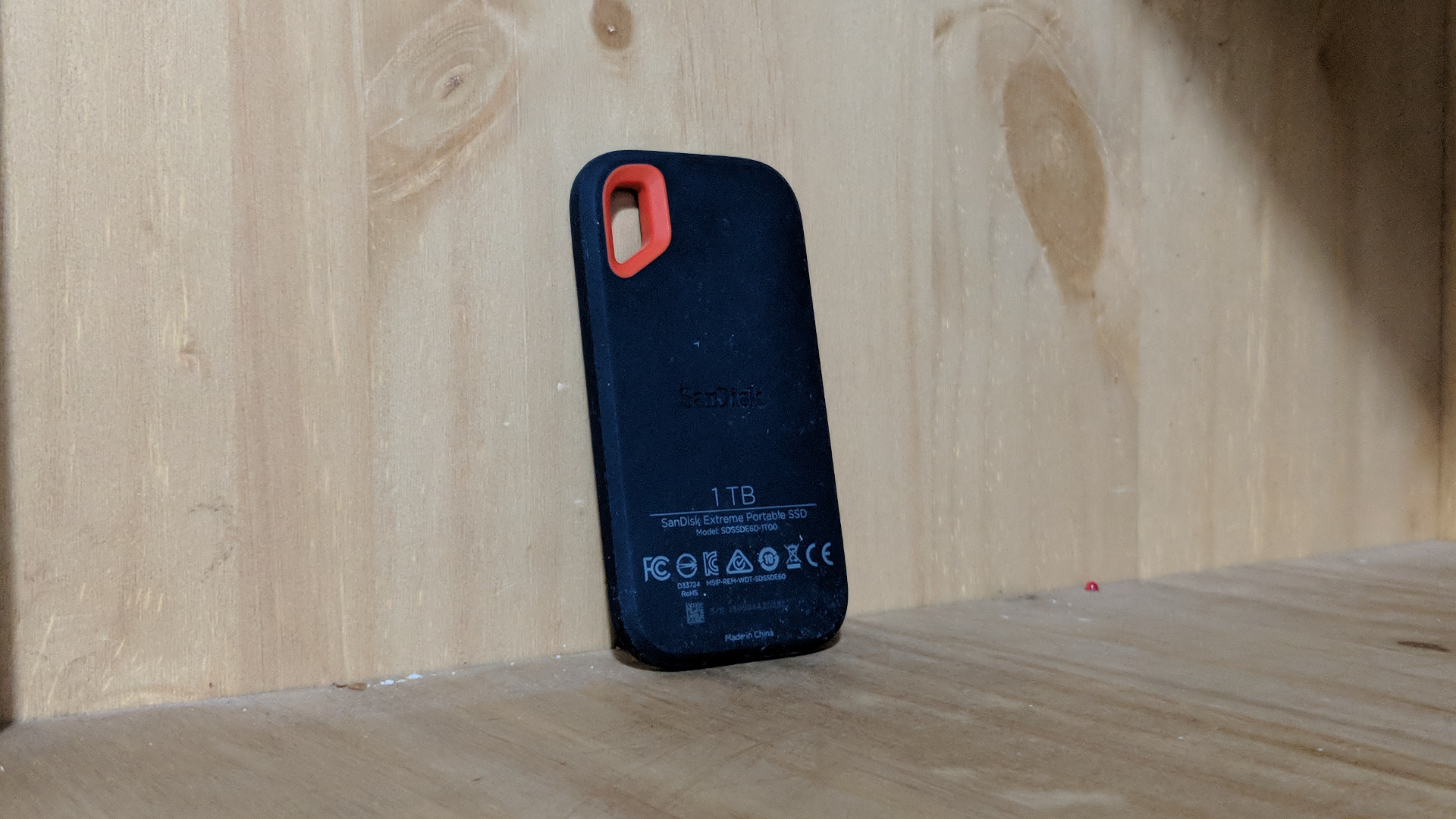TechRadar Verdict
This SanDisk drive is hands-down one of the best external SSDs (rugged or not) on the market, and its 1TB version is particularly attractive compared to the other SKUs. Some cracking performance numbers and a very low price make this product hard to fault.
Pros
- +
Smart design
- +
1TB model is great value
- +
Excellent performance
- +
IP55 rating
Cons
- -
Not totally convinced by the cable
Why you can trust TechRadar
Rapidly falling component costs mean that solid-state drives have never been so cheap, and old favorites are now far more affordable than they used to be. Take for example the SanDisk Extreme Portable SSD (£180 at Amazon UK, $200 at BHphotovideo), an external SSD that is not only rugged and pocket-sized but also affordable, boasting some nifty features.
Four iterations of the drives are available and we’re testing the 1TB model (SDSSDE60-1T00-G25) which comes with a three-year warranty. Other capacities available include 250GB, 500GB and 2TB.

Design
The SanDisk Extreme Portable SSD is not as compact as some of its competitors (like the Samsung T5 for example) but it is thin enough, at 8.85mm, to slip comfortably into one’s back pocket. Its small footprint – 50 x 96.2mm – makes it far smaller than most recent smartphones.
Aimed at an audience that’s likely to use the device outdoors, this SanDisk drive employs rubber for its chassis, with an orange plastic loop at the top-right that can be used to securely attach it to an item. While its edges are smooth, the top and bottom surfaces are textured, which makes handling the drive easier (but equally, gives an appearance that could be confused with a cheap Bluetooth speaker).
The drive carries an IP55 rating for water and dust resistance. Just make sure to keep it well clear of anything that could potentially get lodged in the USB Type-C connector, and permanently prevent you from connecting it to any other device. Also make sure that it is thoroughly dried and cleaned before using it, following any submersion in liquid.
The drive is also fairly shock resistant as it will withstand a drop of 2m on a concrete floor without major damage.

Hardware and performance
The sole connector on the SanDisk Extreme Portable SSD is a USB 3.1 (Gen 2) port which is handy when used with the bundled Type-C to Type-C cable, allowing it to hit up to 550MBps according to the manufacturer – a fraction higher than when you use it with the bundled Type-A adaptor.
We’re not convinced by the latter as its size makes it more likely to be lost. A plastic band tethering it to the main cable might help. Something for SanDisk to bear in mind for the next version of the drive, maybe.
Here’s how the SanDisk Extreme Portable SSD 1TB performed in our benchmark tests:
CrystalDiskMark: 560MBps (read); 501MBps (write)
Atto: 562MBps (read, 256mb); 526MBps (write, 256mb)
AS SSD: 520MBps (seq read); 452MBps (seq write)
We saw some good numbers here, with the caveat that the Type-C connector – not Type-A – was used. This little SanDisk product outperformed all non-Thunderbolt 3 drives we’ve tested with CrystalDiskMark, delivering nearly 560MBps in terms of read speed and just over 500MBps in write. A 100GB file was transferred in 294 seconds, which equates to a transfer rate of about 334MBps.
The drive has a rated maximum data transfer rate of 10Gbps, but in reality, it never reaches that because of the inherent limitations of the physical port.
The Extreme Portable SSD comes pre-formatted as an exFAT device which means that it can work on Windows and Mac out of the box. Reformatting it to NTFS will limit compatibility to Windows but will enable TRIM which will improve the longevity of the drive.
You also get a copy of SanDisk’s SecureAccess 3.02 software that allows you to create a password-protected folder (or private vault) to store all your sensitive files using 128-bit AES encryption. Note, however, that it seems that the application – developed by a third-party called EncryptStick – will store your files temporarily in plain-text.
SanDisk is likely to be using the BiCS Flash developed by Western Digital (WD) and Toshiba, probably the 64-layer version, not the 96-layer one which was released in 2018. The three-dimensional nature of BiCS Flash helps improve performance, reduce heat dissipation and reduce costs, so expect future iterations to deliver even better value for money.

The competition and verdict
There’s not much competition in this price range. The Samsung T5, which costs marginally less and is far more portable, is the only rival that is widely available. It is not IP-rated, though, and its metallic surface is likely to get scratched easily.
The ADATA SE730H is another competitor that perhaps deserves more recognition. It is smaller than the SanDisk Extreme Portable, slight cheaper, and sports an IP68 rating making it far more resilient. Like the Extreme, it has a Type-C connector, a three-year warranty and uses 3D NAND Flash technology – but it is slightly slower and comes from a lesser-known brand.
LaCie, Seagate, Glyph, WD, Lexar and G-Technology also have similar rugged and high capacity external SSDs, but none of them have a unique selling point that would make them stand out against the T5, the SE730H or the SanDisk.
When used with a USB Type-C cable, the SanDisk Extreme rises above the competition with some stellar numbers. The design and form factor are spot on and while we have one reservation regarding the bundled cable, you can’t go wrong at this price.
- We’ve picked out the best portable drives for your PC or Mac

Désiré has been musing and writing about technology during a career spanning four decades. He dabbled in website builders and web hosting when DHTML and frames were in vogue and started narrating about the impact of technology on society just before the start of the Y2K hysteria at the turn of the last millennium.

